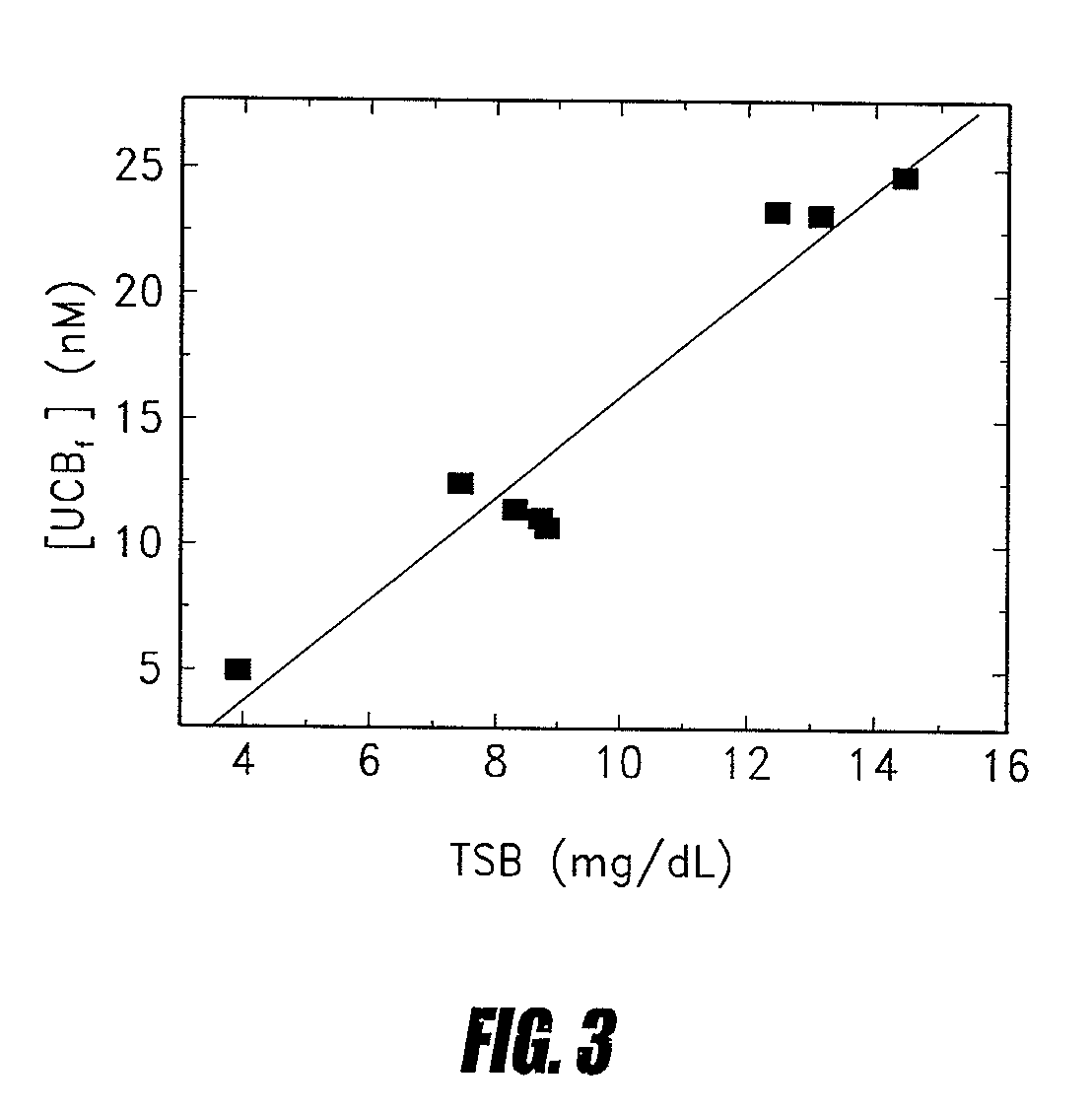Use of probes for unbound metabolites
- Summary
- Abstract
- Description
- Claims
- Application Information
AI Technical Summary
Benefits of technology
Problems solved by technology
Method used
Image
Examples
example 1
Resolving FFAu Profiles in Mixtures of FFA and Albumin
[0093]As a first step towards the determination of blood plasma FFAu profiles, 6 specific probes which are muteins of SEQ ID NO: 4 were used to profile mixtures of 4 and 5 FFA in equilibrium with bovine serum albumin (BSA) (Table 1). Because there is no independent method to determine FFAu concentrations, we also calculated the expected profiles from the known amounts of FFA and BSA used to generate the mixtures. These calculations required binding constants for each BSA-FFA interaction and a new BSA-binding model. Our measurements indicate that, to a good approximation, the binding of each of the FFA to BSA can be described in terms of a single class of 6 to 7 independent sites. Using this simple model, we have calculated FFAu profiles for mixtures of 4 and 5 FFA in equilibrium with BSA and compared these predictions to FFAu profiles measured with our probes. Good agreement was found between these two independent profiling metho...
example 2
Using Multiple Probes to Help Diagnose ST-Elevation Myocardial Infarction
[0096]Early detection of coronary dysfunction is often not possible. For example, the ECG which is the primary early diagnostic tool for acute coronary syndromes is less than 50% sensitive. Thus a sensitive, accurate and rapid test for ischemia is needed for the diagnosis and treatment of patients.
[0097]The magnitude of the sum of the different FFAu in blood (total FFAu—measured with a single probe) increases in patients with cardiac ischemia (see U.S. Pat. No. 6,750,030 which is incorporated herein by reference). The single-probe measurements of FFAu in these previous studies were carried out with ADIFAB or ADIFAB2 and the observed increase in total FFAu was shown to be diagnostic of cardiac ischemia.
[0098]In order to see whether metabolic profiling could provide a diagnostic measurement with greater sensitivity and selectivity, blood samples from the TIMI II trial (blood repository of the National Heart Lung ...
example 3
Analysis Using Bayesian Decision Theory
[0099]Blood samples from 146 healthy controls and 447 TIMI II patients were measured with ADIFAB2 and 6 additional probes (Table 1) as described in Example 2.
[0100]Table 4 shows the results using a classifier to separate these 2 groups derived from two-group Bayesian decision theory using the sample response profiles {ΔRok / Rok}s for each of these 7 probes.
TABLE 4Percentage of samples classified correctly usingBayesian decision theory with 7 probes. All calculations wereperformed with XLSTAT, an Excel add-in for statistical analysis.Healthy GroupMIGroup(Specificity)(Sensitivity)Training Set83.1%90.4%Testing Set85.7%91.7%
[0101]Table 5 shows the specificity and sensitivity for each of the 7 probes of Table 1 used alone to analyze the blood specimens from the same individuals used for the results shown in Table 4. These results demonstrate that using multiple probes greatly improves the accuracy of detecting cardiac ischemia relative to any of the ...
PUM
| Property | Measurement | Unit |
|---|---|---|
| Molar density | aaaaa | aaaaa |
| Molar density | aaaaa | aaaaa |
| Molar density | aaaaa | aaaaa |
Abstract
Description
Claims
Application Information
 Login to View More
Login to View More - R&D
- Intellectual Property
- Life Sciences
- Materials
- Tech Scout
- Unparalleled Data Quality
- Higher Quality Content
- 60% Fewer Hallucinations
Browse by: Latest US Patents, China's latest patents, Technical Efficacy Thesaurus, Application Domain, Technology Topic, Popular Technical Reports.
© 2025 PatSnap. All rights reserved.Legal|Privacy policy|Modern Slavery Act Transparency Statement|Sitemap|About US| Contact US: help@patsnap.com



